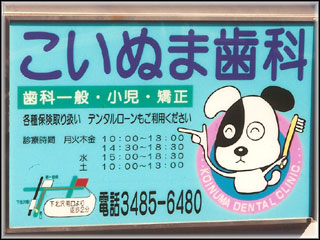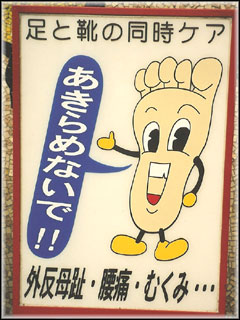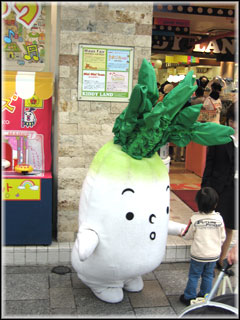Little Friends
6.11.06

One of my favorite things about Japan is the extent to which daily culture is saturated with the presence of little friends. These little friends are cutesy animated characters, everywhere, who infuse playful vivacity into even the most mundane aspects of life.
Looking for Italian food in Tokyo? You'll recognize it by the smiling octopus, eating a plate of spaghetti with two of its tentacles while a couple others wave at passers-by, beckoning them into the local trattoria.
And be vigilant not to wander into restricted areas of the train station. You'll be stopped in your tracks—not by a living breathing civil employee, but by a cartoon kitty-cat baring his claws… a bit too adorable, frankly, to be menacing, yet somehow imposing enough to keep Japanese train-riders in line.
Anyone with the barest knowledge of Japanese pop culture knows about this pervasiveness of little friends—through, perhaps, the worldwide domination of Pokémon (or 'pocket monsters'), Hello Kitty (astrologically-savvy, apparently), and other Japanimation treasures.
 But this is not just kids' stuff. Little friends are literally everywhere… at every bus stop and mini-mart, in advertisements and public service announcements, in full flashing motion on the sides of buildings (thanks to Shibuya's 'Super Lisa' and her video-screen compadres).
But this is not just kids' stuff. Little friends are literally everywhere… at every bus stop and mini-mart, in advertisements and public service announcements, in full flashing motion on the sides of buildings (thanks to Shibuya's 'Super Lisa' and her video-screen compadres).
What a comfort these cartoony chums offer, in the oft-overwhelming crowdedness of urban Japan… where, though you're hardly ever alone, the frenetic buzz of so many people headed in so many different directions can leave one feeling lonely and alienated. Little friends perk us up, and make us smile. With their ubiquitous presence, they're like familiar pets… only without our needing to feed and walk them. Little friends rule, man!
This aspect of Japanese pop-culture touches me deeply, as I'm the type who ensconces myself within a cozy context of little-friend-filled environments.  Maybe it started because, as an only child, I spent a lot of time with my stuffed animals… marrying them off, dividing them into 'stuffie' nation-states, pitting them against each other in Olympic-style competitions, recording all their vital information (birthdates, descriptions, et al) in my trusty blue 'stuffie' binder.
Maybe it started because, as an only child, I spent a lot of time with my stuffed animals… marrying them off, dividing them into 'stuffie' nation-states, pitting them against each other in Olympic-style competitions, recording all their vital information (birthdates, descriptions, et al) in my trusty blue 'stuffie' binder.
In my life, this little-friend trend continues to this day, as any visitor to my home can attest to. Windowsills, bookshelves, and other nooks and crannies are home to, among the many little friends: a tiny family of glass snails, a bunny who plays a drum, a plastic chicken, a wire wombat, and several darling deer, including one who plugs in and lights up. Not to mention all my plant-kingdom pals, such as Rhoda (the rhododendron) and Phyllis (the philodendron). And you can often find me carrying (even coddling) that day's favorite stone in my pocket… a super-sparkly Herkimer diamond maybe, or an invigorating slice of carnelian.
The 'little friend' thing: I get it completely. It's deep in my bones.
I'm no expert on Japanese culture, so I can't detail the precise historical reasons why modern Tokyo is crawling with cute critters. If I had to wager an educated guess, though, I'd track it to pronounced traces of animism a 'primitive' (hmmm) type of spirituality that honors the souls inhabiting everything in nature—not just humans or other animals, but plants and rocks, geographic locations and weather patterns. Japan has a powerful animistic streak in its spiritual tradition (see: Shinto), not unlike similar beliefs held by pagans and other native and tribal groups from around the world. If you spend any time quietly communing with the land or the elements, you understand why.
 Of course, our smarty-pants modern selves are quick to pooh-pooh such simplistic spirituality, as if science has somehow proven the impossibility that any being or object bears a 'soul' or any other such kernel of animistic liveliness. Yet still, we recognize how our finicky automobile, PC or toaster oven has something of its own 'personality'. We sense energies in certain buildings or locales, which either inexplicably draws us in or mysteriously repels us. We prefer one thing over another, for irrational reasons.
Of course, our smarty-pants modern selves are quick to pooh-pooh such simplistic spirituality, as if science has somehow proven the impossibility that any being or object bears a 'soul' or any other such kernel of animistic liveliness. Yet still, we recognize how our finicky automobile, PC or toaster oven has something of its own 'personality'. We sense energies in certain buildings or locales, which either inexplicably draws us in or mysteriously repels us. We prefer one thing over another, for irrational reasons.
Even if it's only our collective need for meaning (neurotic? natural? transformational?) that leads us to invest inanimate matter, or even the basic bio-electrical impulses of 'life', with spirit… so fuckin' what? Aren't we free to decide who—or what—will be our little friends, to accompany us on this sometimes delightful, sometimes discouraging journey? And why wouldn't we surround ourselves with adorably goofy, fun-filled, googly-eyed little characters? Shouldn't we want to inspire bits of joy in life wherever we can find 'em?
This trip, I found myself especially smitten with an animated daikon radish I kept seeing in novelty shops throughout Tokyo. Since I couldn't read any of the text describing this particular daikon, I have no information on its name, origin or personality traits. But it sure is kawai'i (or 'cute')… as a stuffed animal, a wind-up toy, a sticker, or a live character working the streets.
However, one little friend—or should I say, a little Napoleon—was rubbing me wrong the whole time I was in Japan. He's a potato. But no average potato. He's the world's most self-righteous, authority-hungry potato… who wags his white-gloved, scold-happy index finger at anyone who dares to disobey the is Calbee potato-chip party-line. This potato, wearing a sash that reads 'POTATO', in case you're confused, is like Mr. Peanut but bad… and on a power trip.
That damned potato makes me so mad. Not every little friend is my friend.



